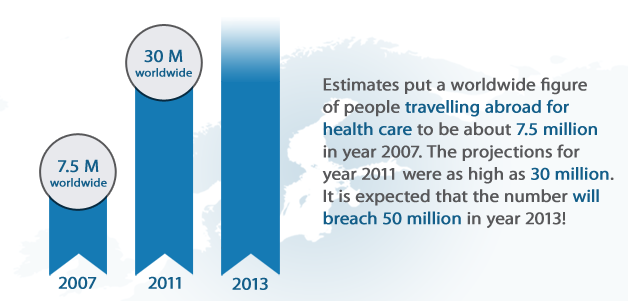Medical tourism
 What is medical tourism? Report by Deloitte put the estimated worldwide figure for medical travelers to be about 7.5 million in year 2007. However, there is a general consensus that the industry has more than doubled since, with projections of about 30-50 million medical touristsin year 2013 (picture on the right borrowed from Wellness Travels). So how come we know so little about this increasing trend?
What is medical tourism? Report by Deloitte put the estimated worldwide figure for medical travelers to be about 7.5 million in year 2007. However, there is a general consensus that the industry has more than doubled since, with projections of about 30-50 million medical touristsin year 2013 (picture on the right borrowed from Wellness Travels). So how come we know so little about this increasing trend?
Introduction
- Significantly higher prices and possible waiting times in the countries of origin;
- Convergence in technology and skills in the destination countries;
- Reduced transport costs and increased importance of internet marketing.
Asian
countries as India, Singapore and Thailand were traditionally dominant players
in this market; however new destinations in Europe are emerging as well. As
stated by the European Parliament (2011) imbalances in the
demand and supply of health services between the member states is a soil for development
of patient mobility. In the European Union, the price of a certain medical
treatment of similar quality may differ by up to three times between countries (Busse,
Schreyögg, & Smith, 2008) . According to Gerdtham & Jonsson (1991) , this is due to the fact
that similarly to other services healthcare depends heavily on labour costs and
labour is more abundant and less expensive in relatively lower income
countries, such as Lithuania. What further increases the potential of medical
tourism within the continent is the relative geographical proximity and ease of
air travel, which allow us to neglect costs and time related to it.
Definition
It is important to first define medical tourism within
the broader context of patient mobility. Therefore in this sub-section a
literature distinction between the two terms is presented. After that the
definition of medical tourism
employed later in the blog is given.
Patient mobility may happen between: 1) two regions
within a country or 2) two different countries (Glinos & Baeten, 2006) .
The former one cannot be classified as medical tourism or export of health
services, since there is just one country involved. According to Lunt et al. (2011) medical tourism
occurs only when international borders
are crossed to acquire medical treatment.
Regarding patient mobility to foreign countries within
Europe and beyond, the literature lists five types of it:
- Temporary visitors abroad. Occasionally people become sick and thus receive medical care while abroad. However as in this case there is no original intention to get cross-border healthcare, it may not be identified as medical tourism. Rather this is coined as ‘unfortunate tourism’ by Lunt et al. (2011).
- Long-term residents. Increasing number of EU citizens is choosing to retire in a member country other than their country of origin (Rosenmöller etal., 2006) and thus receive necessary healthcare services abroad. Yet again such type of patient mobility would not be regarded as medical tourism.
- Shared borders. In the border regions patients may move abroad, since the most proximate medical facility that can carry out the required treatment is over there.
- Institutional agreements. Sometimes agreements to out-source patients are made between two partner medical institutions (or healthcare authorities) in different countries. The purpose of such arrangements varies from each case, but usually these allow saving on costs and/or avoiding long waiting times in the home country. This type of patient mobility may be best described as collective medical tourism (Lunt et al., 2011).
- The most commonly used perception of this tourism niche is the one where people organize the medical trip abroad themselves rather than with the assistance of medical institutions. The main drivers to do so are the perceived advantages, such as price or quality, in the destination country. As stated by Lunt et al. (2011) such medical travellers are acting and should be regarded as consumers in the traditional sense, since they typically choose to pay out-of-pocket.
In order to narrow down the extent of this article,
only the fifth classification falls in the blog’s definition of medical
tourism. This is due to the fact that individual arrangements are the closest
to the regular notion of the term. To sum up, the blog defines medical tourism as following: Individually arranged travel to other countries with the intention to get medical treatment due to various
advantages over the country of residence.
For this time this is it. I hope that later on I will be able to extend the blog with more theory (drivers, implications, etc.) around medical tourism.(Unlinked) Bibliography
Busse, R., Schreyögg, J., Smith, P. C., “Variability in healthcare treatment costs amongst nine EU countries – results from the HealthBASKET project” Health Economics 17, no.1 (2008): 1-8.
Connell, J., “Medical Tourism: Sea, sun, sand and …surgery” Tourism Management 26, no. 6 (2006): 1093-1100.
Gerdtham, U. G., Jonsson, B., “Conversion factor instability in international comparisons of health care expenditure” Journal of Health Economics 10, (1991): 227–234.
No comments:
Post a Comment